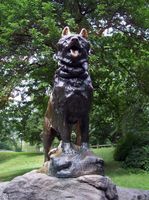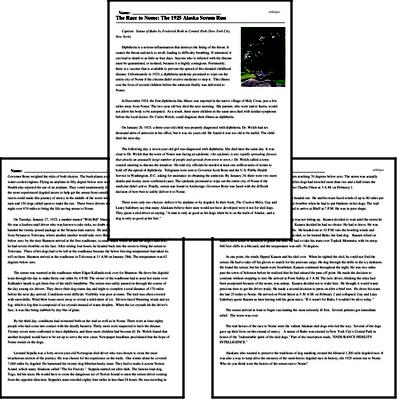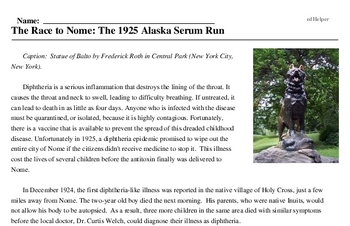The Race to Nome: The 1925 Alaska Serum Run
Caption: Statue of Balto by Frederick Roth in Central Park (New York City, New York).
Diphtheria is a serious inflammation that destroys the lining of the throat. It causes the throat and neck to swell, leading to difficulty breathing. If untreated, it can lead to death in as little as four days. Anyone who is infected with the disease must be quarantined, or isolated, because it is highly contagious. Fortunately, there is a vaccine that is available to prevent the spread of this dreaded childhood disease. Unfortunately in 1925, a diphtheria epidemic promised to wipe out the entire city of Nome if the citizens didn't receive medicine to stop it. This illness cost the lives of several children before the antitoxin finally was delivered to Nome.
In December 1924, the first diphtheria-like illness was reported in the native village of Holy Cross, just a few miles away from Nome. The two-year old boy died the next morning. His parents, who were native Inuits, would not allow his body to be autopsied. As a result, three more children in the same area died with similar symptoms before the local doctor, Dr. Curtis Welch, could diagnose their illness as diphtheria.
On January 20, 1925, a three-year old child was properly diagnosed with diphtheria. Dr. Welch had six thousand units of antitoxin in his office, but it was six years old. He feared it was too old to be useful. The child died the next day.
The following day, a seven-year-old girl was diagnosed with diphtheria. She died later the same day. It was clear to Dr. Welch that the town of Nome was facing an epidemic. (An epidemic is any rapidly spreading disease that attacks an unusually large number of people and spreads from town to town.) Dr. Welch called a town council meeting to discuss the situation. He told city officials he needed at least one million units of serum to hold off the spread of diphtheria. Telegrams were sent to Governor Scott Bone and the U.S. Public Health Service in Washington, D.C. asking for assistance in obtaining the antitoxin. By January 24, there were two more deaths and twenty more confirmed cases. The epidemic promised to wipe out the entire city of Nome if the medicine didn't arrive. Finally, serum was found in Anchorage. Governor Bone was faced with the difficult decision of how best to safely deliver it to Nome.
There were only two choices: deliver it by airplane or by dogsled. In their book, The Cruelest Miles, Gay and Laney Salisbury say that many Alaskans believe their state would not have developed were it not for sled dogs. They quote a sled driver as saying, "A man is only as good as his dogs when he is on the trails of Alaska...and a dog is only as good as his feet."
Governor Bone weighed the risks of both choices. The bush planes available in Alaska had open cockpits and water-cooled engines. Flying an airplane in fifty degree below zero weather was too big a risk. The Board of Health also rejected the use of an airplane. They voted unanimously for the dogsled relay. Governor Bone enlisted the most experienced dogsled racers to help get the serum from outside Anchorage to Nome. Only expert dogsled racers could make this journey of mercy in the middle of the worst winter since 1905. All told, there were twenty men and 150 dogs called upon to make the run. These brave drivers would have to drive a team of dogs day and night over 674 miles to bring the life-saving serum to Nome.
On Tuesday, January 27, 1925, a musher named "Wild Bill" Shannon left Nenana on the first leg of the race. He was a fearless mail driver who was known to take risks, no doubt an explanation for his nickname. He was handed the twenty-pound package at the Nenana train station. He and his nine-dog team would bring the serum from Nenana to Tolovana, where another musher would take over. Because the temperature was approaching fifty below zero, by the time Shannon arrived at the first roadhouse, (a small shack where he and the dogs could rest) he had severe frostbite on his face. After resting four hours, he headed back into the storm to bring the serum to Tolovana. Three of his dogs had to be left at the roadhouse because the below freezing temperature had taken its toll on them. Shannon arrived at the roadhouse in Tolovana at 11 A.M on January 28th. The temperature was 62 degrees below zero.




